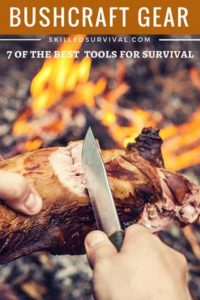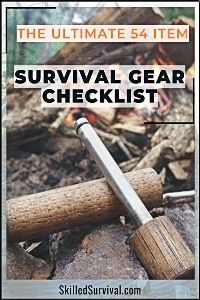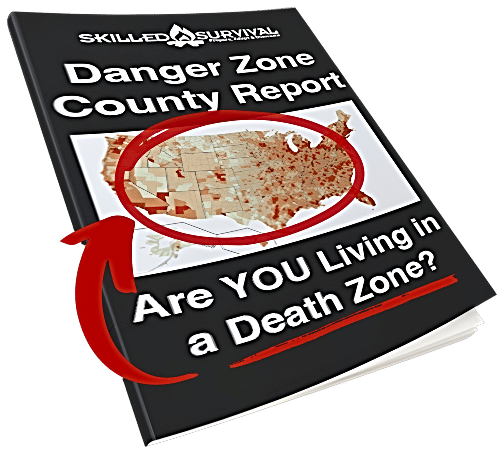
A Complete List Of All The Bushcraft Gear You Should Own
Because bushcraft is a high value skill worth learning.
It’s the art of surviving in the woods with primative tools. Tools such as:
- Knives
- Hammers
- Axes / Hatchets
- Spears
- Etc.
And with just these basic tools, an entire world of possibilities opens up…
TOPICS IN THIS GUIDE… ↓(click to jump)
- What Is Bushcraft Anyway?
- Best Bushcraft Gear Intro
- 1. Survival Hatchet
- 2. Fixed-Blade Knife
- 3. Survival Saws
- 4. Flint and Striker
- 5. DIY Compass
- 6. Whetstones
- 7. Fishing Line & Hooks

Want a free 54 item survival gear checklist?
Click here to instantly download this Complete Checklist PDF. No purchase necessary.So What Is Bushcraft?
Before humans became advanced engineers and scientists, we played by the rules of nature.
If you go back far enough in history, survival was an everyday endeavor; it was the only lifestyle we knew.
No comfortable couch was waiting for us at home, or a steamy hot shower either.
There were no grocery stores or prepackaged food to meet our hunger pains.
And worse yet, no indoor plumbing, so when “nature called,” we were already there because the wild was our home.
Living in those circumstances required a very particular set of tools and skills.
What we today call bushcraft.
Over the years, we’ve refined and perfected our instruments of survival.
And bushcraft became an art form, much like martial arts or rock climbing.
The tools have remained unchanged for centuries, while our computers and iPhones seem to evolve every few weeks.
However, bushcraft gear and tools are timeless.
Today living in a remote off-grid wilderness is much the same as it was for our hunter-gatherer ancestors.
Our bodies need the same security: fire, shelter, food, and water.
And the tools used to secure those needs are impressive in their simplicity and functionality.
Now, in today’s society, we typically don’t get to choose when and where, and under what circumstances we end up stranded in the wilderness.
So a collection of bushcraft tools do you no good stored in your garage.
For example:
If you go down in a plane over the high country, you won’t have many bushcraft tools with you.
(And if somehow you do, kudos, that’s impressive).
Let’s get one important definition out of the way:
The official definition is:
“The skill gained by or necessary for living in bush country.”
↓ What’s Bushcraft?
But I’m going to apply the term more generally in this article.
I am not limiting it to surviving “in the woods or forest” but to in the wilderness at large.
Surviving in the mountains, lost in the woods, stranded on an island, or traversing a desert.
Bushcraft is the art of survival anywhere.
And bushcraft gear is useful in any survival situation.
Best Bushcraft Gear For Getting Started…
Now, you may be wondering…
What can I build with just a handful of tools?
You can build better, more elaborate tools and shelters to survive in:
↓ 10 Bushcraft Camp Projects
Now that you fully understand the power of owning bushcraft tools, lets go over each:
1. Survival Hatchet or Axe
If you haven’t read Gary Paulsen’s book, Hatchet, you need to do yourself a favor and get it now.
The book follows a young man stranded in the wilderness with nothing but his trusty hatchet.
He then uses this hatchet to survive through a winter in the wild alone.
It’s an incredible example of how versatile and useful bushcraft gear can be.
With a quality survival hatchet, you can cut wood for a fire, shape branches for arrows/bows to hunt for food or build a shelter.
The possibilities are endless!
↓ 10 Bushcraft Axe Skills in 10 Minutes
This is exactly why I bring a hatchet with me on every excursion I go on.
For the most part, using a hatchet is straightforward: hack away.
And, if the hatchet’s edge is sharp enough, you can also use it to shave and score wood.
There are tons of places to buy a hatchet.
Any outdoor store or hardware worth visiting will carry an assortment of hatchets.
And if you search online, you’ll find a selection of brands, shapes, weights, and styles to choose from.
You’ll be able to find the right hatchet for you regardless of your style, need, or budgetary restrictions.
Don’t worry; there’s a hatchet out there for you.
↓ Choosing A Proper Hatchet
1. Gransfors Bruk
Gransfors Bruk is my favorite company for hatchets and axes.
These hatchets are high-quality, but they are not the lightest (nor the cheapest).
But you can’t beat the quality.
So you know these bushcraft axes will last you a lifetime.
2. Friskers
If weight is your primary concern, then go with this Frisker 14-inch hatchet.
This hatchet one only weighs 1.4 lbs due to its light (yet still strong) Nyglass (nylon/fiberglass composite) handle construction.
Improvising a Hatchet
The most important part of any hatchet is the head.
It needs to be thick and sharp.
However, it doesn’t need to win a beauty contest.
There are a lot of things that you can use to achieve this.
Scrap metal and sharpened stones are usually the best improvisation options.
Once you select a hatchet head, lash it securely to a handle using cordage.
It should be good to go when you are sure the head will not come flying like a lethal projectile.
Here’s a video showing a stone hatchet without using cordage.
↓ Primitive Technology: Baskets and Stone Hatchet
2. The Fixed-Blade Knives
Few bushman pack tools are as versatile as a survival knife.
There is a reason the knife has been one of the most prominent survival tools throughout history.
Knives are extremely functional.
↓ 10 Bushcraft Knife Skills in 10 Minutes
They serve a lot of different purposes:
- Cutting
- Digging
- Self Defense
- Poking Holes
- Splitting or Batoning
- Perforating
- Shaving
- Using As A Utensil For Eating
- Skinning
- Flathead Screwdriver
In general, if you think you can use a knife to do it, you most likely can.
↓ Bushcraft Basics – Knife Use and Safety
Knives come in all shapes and sizes.
- Some fold, some are fixed, some are double-edged, and others are only single-edged.
- Specialty ones come attached to multi-tools, while others are as basic as possible.
- Some are sleek, and some are just badass looking.
- And yes, some are expensive, while others are cheap.
It all depends on what you’re looking for from your bushcraft knife to decide which one to invest in.
1. Ka-Bar Knives
If you want a big “screw-off” hunting knife, check out Kabars (the official knife of the US Marines).
2. Benchmade Knives
If you want a super lightweight, reliable, folding pocket knife, you can’t go wrong with a Benchmade Knife.
3. Helle Knives
For a fixed-blade knife, I like Helle knives and blades.
They are traditionally Norwegian-made and reliable.
Improvising a Knife
Improvising a fixed blade cutting tool is far more efficient than wasting time, energy, and resources trying to make a folding knife.
Sure, you can do it. But if you’re in a survival situation and need to make something functional, go with a fixed-blade knife.
Fix-blade knives are easier to make, and they get the job done.
The concept of improvising a survival knife is similar to making a hatchet: you need a handle and a blade.
Blades are relatively easy to come by; think like a jailbird and shive up.
Using sharpened metal scraps, sharpened stones, and even glass can work.
Handles can be either fastened to the blade with cord/tape or made entirely by wrapping tape around the end until you have something to grip.
A note on using glass:
Not all shards of glass will work well as a knife blade.
But some forms of glass, like obsidian, are better than even the sharpest metals.
Obsidian blades were commonly used by the Maya people and are SO sharp they cut on a molecular level.
Obsidian can still be found naturally today, so keep your eyes open.
↓ How to make an Otzi the Iceman Flint Dagger
3. Survival Saws
When you are dealing in the wilderness, efficiently cutting wood is a lifesaving skill.
And even armed with a hatchet and a pocket knife, you will not remove fallen trees from across trails.
You won’t be able to cut precise lengths of wood for home building.
For that, you need a saw.
Saws are the ultimate bushcraft tool.
Even if, in your day-to-day life, you never need a saw when out in the bush, you’re undoubtedly going to use it. And use it often.
That saw is going to be essential; I guarantee it.
↓ 10 Bushcraft Saw Skills in 10 Minutes
There are so many types of specialty saws:
- Coping Saws
- Veneer Saws
- Hacksaws
- Crosscut Saws
- Keyhole Saw
- Fret Saw
- Rip Saws
- Bow Saws
- Band Saws
- Folding Saws
- Etc.
But no one will lug their table saw with them in a “sh*t hits the fan” scenario.
So here is a short list of my favorite survival saws.
1. Gerber Saw Folding Gator
This Gerber folding saw comes with a fancy little pack making for easy packing.
The saw is a lightweight bow saw with easily replaceable teeth.
2. Gerber Vital Pack Saw
This is a small, super packable backpacking saw.
It will easily fit into some unused nook or cranny of your pack.
This survival tool is adept at doing exactly that.

Want a free 54 item survival gear checklist?
Click here to instantly download this Complete Checklist PDF. No purchase necessary.How to Improvise a Saw
Improvising a saw in nature is a bit tricky. Saw blades are both precise and unnatural as far as bushcraft gear goes.
So you won’t find them lying around in nature.
Making a wire saw is the closest thing to making an improvised saw.
To do this, you will need two key rings and a length of coarse wire (electrical fencing wire, stripped electrical wires, etc.).
Measure out roughly 3 feet of wire and slip the first key ring halfway along the wire.
Start twisting the wire around itself from the middle (so that you can use the key ring as a handle).
Continue twisting until you reach the end, incorporating the other key ring.
The twisted coarse wire should function as a wire saw.
But remember, this improvised version is nowhere near as effective as the real deal.
But it’s better than nothing in a pinch.
↓ Improvised | Homemade Bushcraft Saw
4. Flint and Striker
Fire is the granddaddy of a survival essential.
I never leave the house without a survival lighter, and I keep a pack of stormproof matches in every backpack I own.
Plus, I bring a fire striker on most trips.
Why? Because a spark has saved countless lives over the years.
And the best part about a striker and flint is it works even if it gets wet.
So if you want to keep an emergency fire starter on your boat, you should use one of these.
If you plan on backpacking through a coastal region, use flint and striker instead of matches.
Lots of outdoor manufacturers and survival companies make flint and striker setups.
Some are cheap and lightweight; others are a little more expensive and flashier.
But they all serve the same purpose, and they are all reliable.
↓ Magnesium vs. Ferro Rod
3 Flint & Striker Options
1. All-Weather Magnesium Kit
This Magnesium Firestarter Kit is simple, lightweight, reliable, cheap, and easy to use; it makes fire.
What more could you ask for in a survival tool?
2. Hand Forged High-Quality Carbon Steel Fire Striker
Fancy, a little heavier, but very elegant.
This handcrafted artisan flint and striker is for those who do not mind spending a little extra.
3. This Bushcraft Survival Ferro Rod
This Bushcraft Survival Ferro Rod is by far one of the more economical ways to go.
Buy a bunch and store one in your car, one in your bug out bag, and one in your backpacking pack.
The bottom line is:
Ferro rods are an inexpensive way to ensure you always have a spark in your pocket.
↓ Proper Ferro Rod use and discussion
Improvising a Flint and Striker
The best part about this piece of bushcraft gear is that it exists in nature.
Unlike a saw or a knife, you can find the materials for flint and striker lying around.
Find two rocks that spark when banging them together. And then get banging.
Or, use a piece of metal to strike against a stone at an angle to generate some sparks.
Not all stones will work, so you may have to try several different types.
But sparks are possible to make in nature without any man-made supplies.
↓ No flint? No problem. How to find a rock that will spark
5. Compass
With luck, you will never get lost in the woods without a compass.
They are essential not only to bushcraft but all outdoor activities.
Whether you are hunting, hiking, fishing, kayaking, or camping, having a true sense of direction is key.
It makes exploring the unknown easier and finding your way back safely.
There is nothing worse than getting lost; compasses help you avoid that.
However, investing in a compass relies heavily on how much you want to spend and how you plan to use it.
I keep a simple Suunto compass in my hiking backpack and transfer it to my other bags if I need to.
But when I was mapping out geologic formations in Boulder, we used very high-tech, multi-purpose compasses.
Specifically, one known as a Brunton Pocket Transit Geo Compasses.
Now obviously, these are not made for survival, but it illustrates the variety available.
Find one that serves your needs and fits your budget.
Improvising a Compass
Despite being a clever article of technology, the compass is simple to recreate in nature.
And it requires only a few basic supplies.
Find a quiet pool of water – preferably a bowl, but a still puddle will work in a pinch. Get your hands on a metal needle.
A sewing needle works but small lengths of wire also works so long as the metal is magnetic (i.e., contains iron, cobalt, or nickel).
Next, place the needle on something that floats (a leaf or a small chunk of cork or a small piece of wood) and gently set it into the center of the still water.
Make sure there is no breeze or wind.
The needle should align according to Earth’s magnetic field.
This alignment indicates North and South.
Magnetic needles are a tried and tested method but require a bit of patience and very stable conditions (i.e., still water and air).
↓ How to make a sewing needle into a compass
6. Whetstones
Equally important to any bladed bushcraft gear are the tools which sharpen them.
Whetstones have been around for as long as bladed tools have and are vital to maintaining a sharp blade.
Here is a good video to learn the techniques of sharpening knives.
↓ How To Sharpen A Bushcraft Knife
Get the stone wet, and run the blade backward along the rock’s surface at a consistent 20-degree angle.
Repeat this until the edge begins to sharpen.
Whetstones are available at most hardware stores and outdoor stores.
Wusthof, Accusharp, and Culinary Obsession whetstones are a few common brand names available.
Make sure you get a whetstone with a coarse grit side and a fine grit side.
These are by far the best for honing your blade edges.
Here are a few more unique ways to sharpen a blade.
↓ 5 Ways To Sharpen A Knife Without A Sharpener
Improvising a Whetstone
Almost all whetstones you find on the market are made from artificial stone.
Plus, the material particles are all the same size and grit found in nature.
Finding sharpening stones in the wilderness is difficult.
You need something very flat, smooth, and dense.
I have heard of people using cinder blocks to hone a rough edge or flat river stones high in quartz.
But finding a random rock that will work well to sharpen your blades will be difficult.
7. Fishing Line and Hooks
These two items are so light, cheap, and packable that every survivalist should carry them.
Hooks and line fit into small zip locks and weighs close to nothing.
And fishing is an essential bushcraft survival skill.
You don’t have to have a full fishing rig to catch something; you need a line, a hook, and some bait.
Plus, fishing line and hooks are available nearly everywhere:
- sporting stores
- outdoor stores
- hardware store
- everything store
- dollar stores
- reuse stores
- military surplus stores
- even many grocery stores
Improvising Fishing Lines and Hooks
As far as bushcraft gear goes, it doesn’t get much simpler than this.
So you need to get your hands on some thin line, and a few aluminum can tops.
The can tops can be cut, broken/bent into a near-perfect improvised fish hook.
Find some bait, and you are ready to cast your line.
↓ Trash To Treasure Improvising Fish Hooks
The Final Word
Of any life skill, I would argue that Bushcraft is one of the most important.
Kids who grow up never learning how to use a hatchet or to whittle things with pocket knives are missing out.
They also are not adequately prepared to handle themselves in the real world.
There is always time to learn, though.
Getting out into the wild and practicing bushcraft is never too late.
Who knows, you may even master the art.
Of course, no bushman was ever successful without their trusty bushcraft gear.
The gear essential to the trade.
And without them, you will struggle to survive in the wilderness.
The bottom line is owning key bushcraft gear is essential for preparation.
But knowing how to improvise any one of these bushcraft tools is equally important.
Because you never know when you might get stranded in the remote wilderness.
Why Trust Skilled Survival...
Go here now to review a full breakdown of:
- Who We Are
- Our Credentials
- Our Mission
- & Product Recommendations...
Here are a few highlights of our teams credentials & certifications:
- Certified Member of a Mountain Search & Rescue Organization
- Plant Emergency & Safety Leader for a Major Food Manufacturer
- Member of the 10TH Mountain Division Hut Association
- Certifications: Avalanche 1, WFR, CPR
- Official Gear Tester for Numerous Outdoor Gear Companies
- Countless Multiday Backpacking trips into Remote Wilderness
- Bachelor's Degree In Mechanical Engineering
- Bachelor's Degree In Civil Engineering
- Bachelor's Degree In Biomedical Engineering
"It takes 20 years to build a reputation and five minutes to ruin it." - Warren Buffett
We're fully aware that trust is NOT something you GET but is EARNED.
And we'll continue to earn YOUR trust through our forthright and honest approach with each new Blog Post, Guide & Product we create...
Will Brendza

P.s. Do You Live In A 'Danger Zone' County?

Find out now using my Danger Zone County List & Special Report it’s absolutely FREE.
In minutes you’ll know EXACTLY where you stand and if you should be worried or not..
So click here to get my FREE Danger Zone County List & Report…

Recommended Reading
LifeStraw Review: An Expert Puts It To The Ultimate Test
LifeStraw Review - with no moving parts, chemical additions, or batteries, it provides a lightweight, compact filter to treat up to 4000L...
Best Survival Bow: 16 Surprising Reasons YOU Should Get One
A survival bow is one of the most underappreciated weapons I think EVERYONE should own. Here are 16 reasons why YOU should get one today.
Best Survival Hatchets: Tough Enough To Outlast The Wild
Not all hatchets are created equal. A quality survival hatchet can do tasks even a survival knife cannot. Here's the one I carry in my pack.
Best Survival Radios: Why You Must Secure One (before SHTF)
Be the ONE who knows what the hell is going on after SHTF. Here's how to set yourself up with a reliable survival radio in a future disaster.
Best EDC Flashlights: Small, Compact But Still Super Bright
The best edc flashlights are durable, bright, compact and worth carrying! In this guide, we review the best one to make your search easy.
11 Proven DIY Survival Gear Projects ANYONE Can Follow
Building DIY survival gear doesn't NEED to be complicated to be effective. Here are the 11 best projects you can finish in just a few hours.










